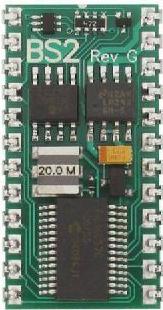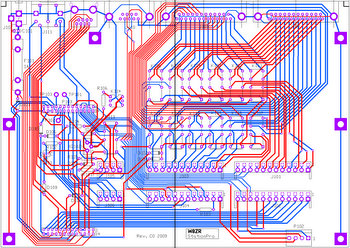Inside the StationPro
Project History
Back in the 1970s, my primary station was a Drake "C-Line" (R4C receiver and T4XC transmitter), and my backup station was a Kenwood TS-520 transceiver. I also had a Drake L4B linear amplifier and a homebrew linear amplifier. After several years of frustrating cable-plugging, I finally built a "station controller" to handle the switching, with the RF switching done by military surplus coax relays and motorized coax switches. The photos at the right show this "Mark I" station controller.
After building my "dream" hamshack in 2007, I retired my old station controller and decided to replace it with a 21st century design. My 1970-era controller was bulky, heavy, and trouble-prone, and it only allowed for transfering the key and microphone between rigs.
The new StationPro is a fraction of the size of the original, vastly more flexible and - knock on wood - has been 100% reliable. I have three of the units in my station and collectively they have logged more than 30,000 hours of operation.
W8ZR's original station controller, circa 1975
|
|
The idea for the StationPro took off when I discovered PCB-mount power relays that handle high power RF, with negligible VSWR and insertion loss. The photo at left shows a VSWR test of the StationPro's RF relay unit. The MFJ analyzer indicates a 1.0 VSWR at 28 MHz and only rises to 1.2 at 54 MHz.. The RF relay unit has been tested to 2500W on the HF bands, and 800W on six meters (the maximum power from my station), with nary a problem. |
|
One of my design goals for the StationPro was that other hams would find it useful. I researched commercial controllers, and they all were too limited in their capability. Most switched audio, and sometimes data and other control functions, but none could also handle RF. Some seemed to go overboard (in my opinion!) in providing minimally useful level adjustments to equalize settings between rigs. In truth, audio levels like Line In, Line Out, etc., are pretty well standardized among different brands of transceivers and, of course, all transceivers have front panel mic gain controls. |
|
|
After noodling around various designs, I realized that many hams didn't need all the capacity I wanted for my own station and my collection of vintage rigs. For many amateurs, a station controller that could handle two transceivers and two linear amplifiers would be perfectly adequate. That's why I finally settled on two versions of the StationPro - a relatively uncomplicated controller (the SP-I) and a microprocessor-operated one (the SP-II) for hams with more complex stations. Since needs change, though, I also wanted builders of the SP-I to be able to ugrade to the SP-II without losing their investment.. |
StationPro I controls two transeivers and amplifiers |
|
One feature common to both the SP-I and SP-II is an amplifier keying circuit. Many newer transceivers cannot key the relays of older linear amplifiers, because of their high voltage and current requirements. I looked at the designs of aftermarket keying circuits, but most seemed to have undesirable features (e.g., clicky relays, positive voltages only, too slow). In the end, I designed an amplifier keying circuit that is fast enough for QSK, silent, and able to accomodate the relay circuit of any amplifier, commercial or homebrew, including those using AC relays. |
|
 |
The microcontroller in the SP-II is a Basic Stamp BS2IC (Left). I'd used Basic Stamps in my high power "EZ-Tuner" a few years back, as well as in a homebrew QRP transceiver, and found them to be extremely reliable and easy to program. Since other hams were going to build the StationPro, I felt it important that programmng it not require any special equipment or prior experience. The BS2IC fills this requirement nicely, and can be programmed with any computer that has a serial port. |
|
Software development is always a work in progress, and that is certainly true for the firmware in the SP-II. I spent many months debugging the code and trying out various features. One of the latest features is a built-in timer that allows users to track hours of station operation. It can also be used to monitor contest hours, or even the hours on the tubes in a linear amplifier. Another important feature is the ability for builders to enter their own station equipment into the code, so that their selected rigs will display on the LCD. I have a few other ideas in the hopper for future revisions, and hope other builders can come up with additional innovations. The firmware is most definitely "open source," and hacking and experimenting is encouraged! |
|
| I went through numerous reworks of the circuit board layout and four sets of prototype boards before I was finally satisfied with the design. At the right is the final layout of the traces for the main printed circuit board. The red lines are the top side of the board, and the blue traces are the bottom side. All the white areas in the finished boards are filled in with a ground plane. Careful attention to layout and quite a bit of trial-and-error has resulted in a design that is both stable and reliable. |
 |
|
It has taken more than two years for me to design, test, and debug the StationPro, and to get it ready for other hams to build. My computer has more than 900 files and 65 directories devoted to the StationPro, and to date there have been twenty-one firmware updates. I have taken particular pains to make comprehensive and detailed step-by-step assembly manuals, and to provide complete documentation. The manuals and other documents are are fiilled with photos and illustrations, and patterned on the excellent manuals from Elecraft, and the old Heathkit manuals of yore. (Remember those?) All of this effort is intended to make the StationPro reliable, bug-free, and both fun and educational to build. Because I don't have the capability to sort thousands of components into little bags, I'm not able to sell complete kits to builders. However, I've tried to do the next best thing, which is to supply "semi-kits" (circuit boards and pre-punched and silkscreened enclosures) and make it very easy for builders to order the remaining components on-line. Builders can download filled-out order forms and place their orders in a few minutes. I use Mouser Electronics as my recommended supplier, because I've used Mouser for years and have always found their prices to be reasonable, with no required minimum order, and fast service. Of course, builders with well-stocked junk boxes can easily edit out from the order form any components they already have, or use any other supplier they prefer.. Many hams have inquired whether I plan to sell assembled StationPros, and unfortunately the answer is no. In fact, the primary reason I publicize my homebrew projects is to encourage hams to head to their workbenches and develop their skills. In my earlier career I was a professor of experimental physics (at Ohio State University and Miami University). My interests in science and technology got their start because of ham radio. As a teen-ager, the time I spent wiring up Heathkits, breadboarding circuits, and playing around with antennas helped lay the groundwork for a very rewarding and satisfying career. In these modern times, it's not easy for hams of any age to get that kind of experience. And so I see my StationPro as one step in filling that void. You want a StationPro for your own rigs? Well then, you'll have to fire up your soldering iron and build it yourself. Go ahead and take the plunge. I promise you'll enjoy yourself! |
|